Canterbury: Still the Perfect Pilgrimage!
by Julia Hickey
The site of the city of Canterbury has been occupied since prehistoric times; Neolithic round barrows and Bronze Age artifacts have been found in the area, and even before the arrival of the Romans, "Durovernon" (from the British "duro" or fort, and "verno" or swamp) was an important Kentish settlement. The Romans named it "Durovernum Cantiacorum," and made it a central administrative centre, for it lay at the junction of the roads to three Roman ports: Regulbium (Reculver), Dubris (Dover) and Lemanis (Lymphe). It stands up on the major Roman road that became known (and is still known) as Watling Street. The name Canterbury itself comes from the Old English Cantwarebyrig, or "fortress of the men of Kent."
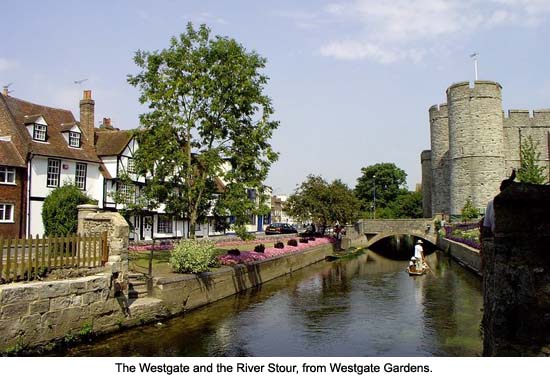
Still largely enclosed by its medieval city walls, Canterbury is
a vibrant bustling place with much to offer the modern pilgrim.
Be warned, though: by the time you have finished exploring this
neat little city, your feet will feel as if they have made the
pilgrimage from London to Canterbury just like Chaucer's
pilgrims!
Begin your pilgrimage at the Westgate Tower at the bottom of
St Peter's street. Built of Kentish ragstone in about 1377, it is
the last survivor of Canterbury's seven medieval gates. Climb the
narrow twisting stairs to the first floor, where there is a small
museum giving information about the city walls and also about the
role that the Westgate Tower played during earlier centuries as a
prison. Take time to look through the murder holes at the traffic
passing beneath you. Then climb to the ramparts for a real treat:
a view of the city's higgledy-piggledy red pan-tiled roof tops
leading towards the majestic cathedral that soars skywards. The
City Fathers are very protective of their skyline. Buildings must
not interfere with the view of the cathedral. Beneath the
ramparts St Peter's Street is filled with a sea of shoppers. In
the east you may catch a glimpse of Canterbury's ruined castle.
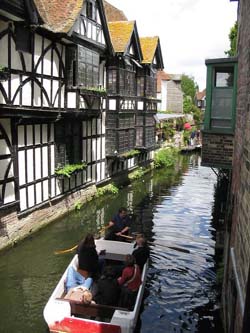 Join the waves of people on St Peter's Street moving
up and in towards the centre of the city. The street climbs
gently until you are almost on the River Stour itself. There is a
striking Tudor building on the left side of the street just
before the river. The blacked timbers and the mullioned windows
are the frontage of a Tudor Merchant's House. The place is called
The Weavers after the Huguenot refugees who found sanctuary here
in the 16th century. Join the waves of people on St Peter's Street moving
up and in towards the centre of the city. The street climbs
gently until you are almost on the River Stour itself. There is a
striking Tudor building on the left side of the street just
before the river. The blacked timbers and the mullioned windows
are the frontage of a Tudor Merchant's House. The place is called
The Weavers after the Huguenot refugees who found sanctuary here
in the 16th century.
On a sunny day pause on King's Bridge -- it's an 11th-century
creation -- to enjoy the sunlight bouncing from the water and
smile at the antics of Canterbury's ducks. It is impossible not
to notice the ducking stool where scolds, nagging women and
suspected witches were strapped before being submerged beneath
the water. It doesn't take much imagination to see Chaucer's Wife
of Bath protesting loudly at being ducked here.
Time to cross to the right hand side of the bridge. The
chapel-like building with the fine Norman arch showing just how
much the street level has risen in 900 years is called
Eastbridge. More properly, it is the Eastbridge Hospital of St.
Thomas and is Canterbury's oldest surviving building. Step into
the darkness and leave the noise of the 21st century behind you.
Inside Eastbridge you have entered the world of the medieval
pilgrim. Imagine them resting here -- footsore and weary --
before beginning their final journey to Canterbury's great
cathedral.
"Hospital" simply meant "hospitality," and
the refectory and undercroft give modern visitors some idea of
how soothing this place must have been to the pilgrims. The
ceilings in this place are truly amazing; you may have a sore
neck by the time you get outside! The mural in the refectory
ceiling dates from the 12th century and shows the martyrdom of
St. Thomas a Becket. Although there's no evidence that Chaucer
came to Canterbury, he would have been familiar with hostels like
this and it is not hard to place his famous band in its walls.
[Read more about The Hospital of St. Thomas.]
Continue up St Peter's Street. Stour Street is on the right
side of the road. This quiet side street contains two delightful
secrets. The first is hidden behind a pair of double black gates
next to the Grey Friars Guest House. Welcome to the oldest
Franciscan building in Britain! Even more delightful is the fact
that it sits across the river in tranquil surroundings. Wander
through the little exhibition about St. Francis and St. Claire or
just enjoy the gardens. The wonderful thing about Canterbury is
that despite the hustle and bustle of modern city life, there are
many hidden places to relax and come face to face with the past.
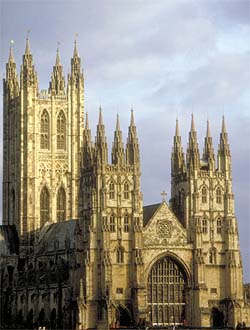 Continue along Stour Street to the Poor Priests
Hospital. If you visit on a Saturday, do not be surprised to find
a bride posing here for her wedding photographs. It's a favourite
place for a picture of the happy couple! And no wonder; the
13th-century stone work is mellow with age and the roses in the
garden just invite photographers to get clicking. The building
houses the Museum of Canterbury. Set time aside for this
experience as it involves a walk through Canterbury's history
from Roman times until the present day. There's an original
George Stephenson locomotive and a copy of an Anglo-Saxon
portable sundial. The exhibition detailing the building of the
cathedral is fascinating. Find out who William of Sens was and
how he fell from the scaffolding around the growing cathedral. Of
course no visit to the museum would be complete without getting
to know more about Rupert Bear. The little white bear with his
yellow check trousers, matching scarf and red sweater was created
in Canterbury by local artist Mary Tourtel (1874-1948). For many
British children Christmas just wouldn't be Christmas without a
Rupert Bear annual and the adventures of Rupert and his friends
-- all speaking in rhyme, making memories sublime! Continue along Stour Street to the Poor Priests
Hospital. If you visit on a Saturday, do not be surprised to find
a bride posing here for her wedding photographs. It's a favourite
place for a picture of the happy couple! And no wonder; the
13th-century stone work is mellow with age and the roses in the
garden just invite photographers to get clicking. The building
houses the Museum of Canterbury. Set time aside for this
experience as it involves a walk through Canterbury's history
from Roman times until the present day. There's an original
George Stephenson locomotive and a copy of an Anglo-Saxon
portable sundial. The exhibition detailing the building of the
cathedral is fascinating. Find out who William of Sens was and
how he fell from the scaffolding around the growing cathedral. Of
course no visit to the museum would be complete without getting
to know more about Rupert Bear. The little white bear with his
yellow check trousers, matching scarf and red sweater was created
in Canterbury by local artist Mary Tourtel (1874-1948). For many
British children Christmas just wouldn't be Christmas without a
Rupert Bear annual and the adventures of Rupert and his friends
-- all speaking in rhyme, making memories sublime!
Return to St Peter's Street. Technically this is now the High
Street and if you look up when you reach the junction with
Guildhall Street, you can see the road signs for Dover and London
-- reminders of a time when Canterbury was not pedestrianised.
There are two buildings to look for as you walk up this street.
The first is on the left side and is the most modern building on
the tour. The Beaney Institute is an imposing Victorian building
with steps leading up to the main entrance, arched windows on the
ground floor and mullions on the second. The black beams echo the
medieval and Tudor buildings. It houses a library, art gallery
and the regimental museum of the Buffs. The art gallery is a
lovely place to spend a rainy hour or so. There is something very
oldfashioned about the way that the pictures as presented so that
they vie with one another for attention. Then there are cabinets
filled with porcelain and other fine objects. It is rather like
stumbling upon an Aladdin's cave of art. For the more
military-minded, the Buffs Regimental Museum tells the story of
one of Kent's finest regiments from its formation in Tudor times.
Can you spot the Victoria Cross?
The other building to look out for on the High Street is also on
the left side of the road. It's hard to miss this wedding-cake of
a building with its pink and white plasterwork. Even better is
the fact that it houses a coffee shop, and by now even the most
hardened history hunter is probably in need of a strong dose of
caffeine and slice of something calorie-laden. Whilst you are
enjoying your coffee, imagine what might have happened in the
room above your head in 1573. This building is all that remains
of the Crown Inn. It is special because this is the place where
Elizabeth I met the Duke of Alencon when he came a-courting.
(Ultimately she rejected him.)
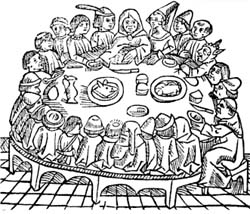 Continue up the hill until you reach a crossroads.
Turn right into Margaret's Street. Continue along the road until
you pass a church. It is now the home of the Canterbury Tales
Museum. No trip to Canterbury would be complete without hearing
more about Chaucer's pilgrims and their saucy stories. The
waxworks inside the exhibition are accompanied by an audio that
brings medieval England to life. [Read more about The Canterbury Tales.] Continue up the hill until you reach a crossroads.
Turn right into Margaret's Street. Continue along the road until
you pass a church. It is now the home of the Canterbury Tales
Museum. No trip to Canterbury would be complete without hearing
more about Chaucer's pilgrims and their saucy stories. The
waxworks inside the exhibition are accompanied by an audio that
brings medieval England to life. [Read more about The Canterbury Tales.]
Discover the Three Tuns Inn at the end of this road. It was built
in the 15th century and is popular with tourists and students
alike. Turn left and you will be standing on Watling Street, or
else follow the road around the inn and continue to the castle.
This was built by the Normans 1080, replacing an earlier motte
and bailey fortification built at the nearby Dane John. The stone
keep seen today was constructed during the reign of Henry I
(1100-1135) and was one of Kent's three royal castles; by the
13th century it had become the county gaol. Over the centuries,
it survived whatever history had to throw at it until the time of
the Victorians, who decided that it was in exactly the spot where
they wanted to build a gas works. They set about destroying it by
blowing it up. They failed! The shattered, weed-grown walls are a
testament to the medieval builders who first raised them when the
Stour was still a navigable channel. Visitors are not allowed in
the building as it is too dangerous.
Return to the High Street. Cross over the main thoroughfare and
down the narrow cobbled lane leading towards the cathedral. Pause
to consider Henry II walking barefoot over the cobbles in public
penance for his part in the death of Thomas a Becket. The alley
opens out onto the Buttermarket and the Christ Church Gate
entrance to the cathedral. Still feeling thirsty? Take advantage
of Debenham's coffee shop. The best thing about the coffee shop
is its location in some ancient vaults. Morelli's ice cream
parlour, also on the Buttermarket, is something of an institution
in Canterbury and should not be bypassed!
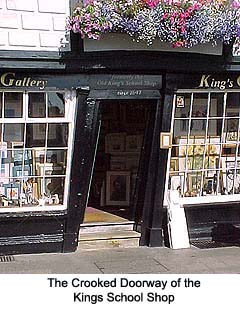 Turn
left into Sun Street. Pause when you have passed the jewellers on
the left side. This is the Sun Inn, where Charles Dickens stayed,
and it is well worth a photograph with its red gable end,
three-storey timber structure and herringbone brick patterns. The
jewellers housed in this building display some of the Duchess of
Windsor's jewels. If visitors continue down Palace Street they
will be rewarded by discovering a medieval building that seems to
lean at an impossible angle; it is one of the oldest schools in
Britain. It is impossible not to notice the King's School Pupils
in their distinctive pin stripe trousers and winged collars. The
school is not open to the public, but you can visit the shop (the
doorway was built at a slant deliberately to emphasize the
overall crookedness of the Tudor building). Turn
left into Sun Street. Pause when you have passed the jewellers on
the left side. This is the Sun Inn, where Charles Dickens stayed,
and it is well worth a photograph with its red gable end,
three-storey timber structure and herringbone brick patterns. The
jewellers housed in this building display some of the Duchess of
Windsor's jewels. If visitors continue down Palace Street they
will be rewarded by discovering a medieval building that seems to
lean at an impossible angle; it is one of the oldest schools in
Britain. It is impossible not to notice the King's School Pupils
in their distinctive pin stripe trousers and winged collars. The
school is not open to the public, but you can visit the shop (the
doorway was built at a slant deliberately to emphasize the
overall crookedness of the Tudor building).
Alternatively, turn right and walk up towards Burgate -- not too
far, though. Turn right into Butchery Lane. It's not hard to
guess what the medieval dwellers of this street did for a living!
Sadly, the buildings on the right side of the street are a new
development. This is the edge of the area that was destroyed by
the Baedeker Air Raids of 1942 (so called because the places
targeted were selected from the famous guidebooks). The
devastation was recorded in 1944 when A Canterbury Tale
was filmed on location.
Incredibly, during reconstruction work a Roman pavement was
discovered in 1946. Today it can be seen in situ in the
Canterbury Roman Museum. Travel back in time to the city of
Durovernum Cantiacorum. The museum is quite incredible; as
well as the pretty mosaic with its central flower, heart shaped
leaves and woven border, here one can see the metal parts of a
horse's harness, keys, dice, lamps, leather shoes, pins and
needles, combs and bowls.
Continue towards Burgate. Pass through the city walls, cross the
road and enter Longport. Follow the signs directing visitors to
St. Augustine's Abbey. Look out for the water conduit set just
beyond the sharp corner you turn to reach the abbey. It was a
gift to Longport in the 19th century to help prevent cholera.
This is an extremely unusual conduit because it is fashioned from
cannon that saw action during the Crimea War.
St. Augustine's Abbey is a World Heritage Site run by English
Heritage. The ruins are given life by the informative audio tour
that helps visitors get their bearings. It was founded in AD 597
and came to an end with the Dissolution of the Monasteries during
the reign of Henry VIII. Given its location next to a thriving
city, it is not surprising that very little of the abbey remains
in comparison to the great northern monasteries of Fountains,
Rievaulx and Mount Grace. Nevertheless, the site is impressive.
Look closely to find medieval tiles depicting fleur de lis and
flowers. It is possible that these tiles were fired on Tyler's
Hill on the other side of the city. The museum houses some fine
examples of masonry and tells the abbey's story. Here, visitors
get the chance to see some of the artefacts unearthed over the
years, including the burial mitre of Abbot John Dygon. Do not
forget to admire the modern panel showing the construction of the
great walls. [Read more about St. Augustine's Abbey]
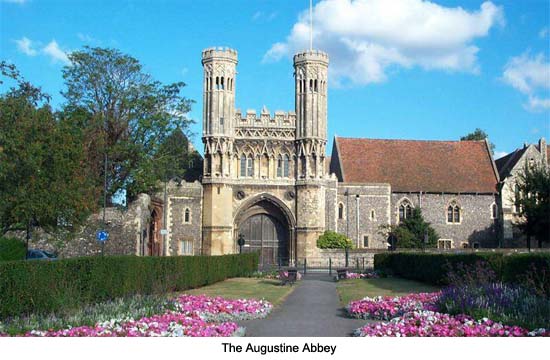
Return to the city. Instead of walking down Burgate back to the
cathedral, turn left onto the city walls. The foundations are
Roman but the majority of the flint structure is medieval. The
path leads down from the wall into the main shopping area of the
city. Look out for the tower of St George's Church, where Tudor
playwright and spy Christopher Marlowe was christened. Sadly the
rest of the building, along with the house where this infamous
playwright was born, were both destroyed in the 1942 air raids.
In the White Friars area of the shopping centre, take a good look
at the pavements. This new development was created after
extensive archaeological survey of the area. The pavements depict
the round houses, the hearths, the wells and the burials
discovered by the archaeologists. It is a wonderful reminder for
Canterbury's modern pilgrims that there is more than 2000 years
of history beneath their feet.
Finally, make your way along the walls to the Dane John Gardens.
Legend has it that the Vikings martyred an archbishop of
Canterbury here by shooting him with arrows. The reality is that
the mound called the Dane John is a corruption of the word
donjon and reflects the fact that this is the first Norman
motte to be thrown up shortly after the battle of
Hastings. The gardens are a delightful spot to sit and reflect on
all the sights and sounds that Canterbury has to offer.
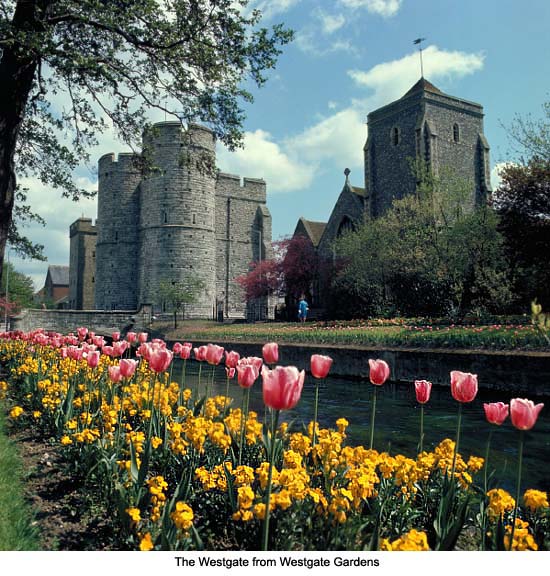
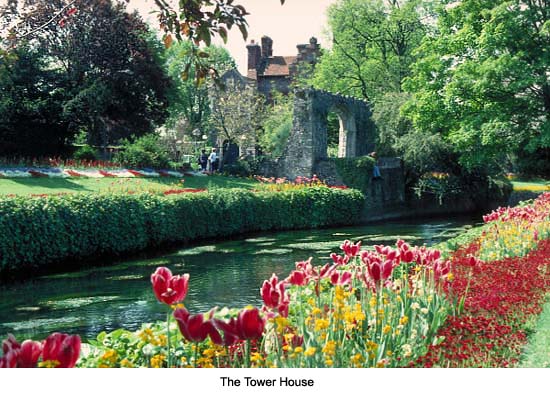
Related Articles:
- Canterbury Cathedral, by John P. Seely
- https://www.timetravel-britain.com/articles/churches/canterbury.shtml
- Timeline: Canterbury, by Darcy Lewis
- https://www.timetravel-britain.com/articles/towns/cantime.shtml
- Read More About:
- The Hospital of St. Thomas
- St. Augustine's Abbey
- The History of the Archbishop of Canterbury
- The Canterbury Tales
- Thomas Becket
More Information:
We regret that we no longer have the resources to maintain up-to-date links and/or hours and pricing details for the various sites and attractions listed on this website. For more information about the location(s) listed above, please use your favorite search engine or visit Wikipedia.
Julia Hickey is passionate about England's heritage and particularly of Cumbria, where her husband comes from. In between dragging her family around the country to a variety of historic monuments, she works part-time as a senior lecturer at Sheffield Hallam University. She spends the rest of her week writing. In her spare time, she enjoys walking, dabbling in family history, cross-stitch, tapestry and photography.
Article © 2006 Julia Hickey
Photo of Kings School Shop © Stephen Bax . Westgate and the River Stour © 2006 by Michael Pead, courtesy of Wikipedia.org). Canal photo © 2005 by Michael Bell (courtesy of Wikipedia.org). Canterbury Tales woodcut dated 1484 (courtesy of Wikipedia.org). Hospital of St. Thomas from The Mirror of Literature, Amusement, and Instruction, Vol. 10, No. 268, August 11 1827 (courtesy of Wikipedia.org). St. Augustine Abbey courtesy of Wikipedia.org. Canterbury Cathedral courtesy of Britainonview.com. Westgate and Tower House courtesy of Britainonview.com.
| 